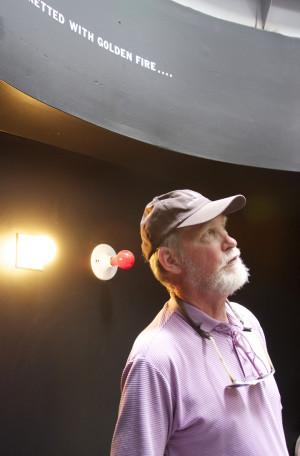By Hal Walter
At some point it sunk in that I was standing high up on a ladder, hefting a chainsaw to cut a branch on a big ponderosa pine, and doing so without any sort of safety net, spotter or even healthcare coverage.
The irony was that I was performing this daring act of bad judgment in the name of insurance. Suddenly the blade upon the branch brought into sharp focus how much of our lives are spent literally working for the insurance industry. We pay for healthcare insurance, which is really “diseasecare” coverage. We insure our homes and their contents, and our cars. We insure our lives as if death were only a gamble. Some people even buy insurance for their computers and cell phones.
Recently we received word that our homeowners insurance required us to list wildfire mitigation steps we’d taken in order for our policy to be continued, to answer questions regarding the physical surroundings of the home, and to send written notice of such, as well as photographs. This new requirement arose from the devastating loss of homes in Colorado wildfires in recent years.
While I generally keep the area around the house mowed and low branches cut, this letter from the insurance company put me on edge because I couldn’t bear the idea of any further insurance rate increases. There were a few more branches I felt could be lopped, and with all the recent rainfall, some additional mowing that would make the house even more wildfire-safe.
Even without these measures, I feel our home is one of the safest from fire danger in this area. It is positioned on relatively flat ground sloping gently north, and protected on two sides by wide county roads as fire breaks. The house itself is situated in a small stand of ponderosa pine trees. But these are mature, spaced and healthy trees isolated a fair distance from the wildfire danger that exists on neighboring ridges. Even if fire were to get close, with the area around the house mowed and grazed, and limbs of trees trimmed high, the chance that flames from grass or undergrowth could jump into the trees seems relatively slim.
As a student of environmental conservation, I am well aware of the potential dangers of living in this mountain ecosystem. However, I also know the thick bark of mature ponderosa pines is fire-resistant, a genetic adaptation to the fire ecology of this mountain ecozone. Fire is nature’s way of clearing out the underbrush, and well-spaced and healthy Ponderosas are well-adapted to withstand fires on the ground. It is when trees become overcrowded and diseased, and when underbrush becomes overgrown, that fire can jump into the tree branches and cause what is known as a “crown fire.”
Meanwhile, my “healthcare” coverage had become an even bigger issue around here. With the advent of the Affordable Care Act, I found myself in a unique position. I supported the president and the ACA. Many of my friends, some who have never had insurance in their entire lives, were helped by the ACA and I am glad for them. The system was completely out of control and everyone should be able to afford health care. But the fact of the matter is people like me got left behind in the deal, and the only thing I got was a bigger bill.
As the new law was going into effect, we had applied for Medicaid buy-in coverage for my son Harrison, who has autism. I had been carrying a major medical policy with a $5,000 deductible that covered both of us in case of some catastrophe, and the premium for it was about $340.
Within about a month we received word that Harrison was accepted into the Medicaid program at a cost of about $120 a month. Meanwhile, Anthem notified me that the premium for the major medical policy would be going up.
I figured this would be no problem since I would now be removing Harrison from that policy. But when I contacted Anthem I was told the new rate would be about $430 per month for just me, and that I did not qualify for any of the Obamacare subsidies either. Yes, I am a healthy and fit non-smoker, have never been hospitalized, have no history of illness or disease or preexisting conditions, take no prescription drugs, etc. Months of phone calls and shopping around for another provider ended in frustration.
So suddenly my total healthcare cost for myself and my son had gone from $340 to about $550. Go on my wife’s plan at work? That would cost even more.
I’ll spare the details but the insurance bills around here add up to more than the mortgage payment. More than the fuel bill, too. At least with a mortgage you get a roof over your head, and when you buy fuel you get to go somewhere. When you spend money on insurance, you get, well, … basically you’re gambling. Gambling that your house might burn down. Gambling that you might get in a car wreck. Gambling that you might get sick or injured. Gambling that you might even die when it’s a pretty safe bet you will at some point.
Especially if a branch you’re cutting with a chainsaw swings around and swipes the ladder out from under you. But I’m smarter than that. As the branch sagged I could see there was no way to ensure the worst would not happen, so I left it hanging. I climbed down the ladder and cut back the branch from the ground so there was less to swing. Then I went looking for my cross-cut hand saw, climbed back up the ladder, slowly and surely sawed through the last few fibers and watched the branch drop safely to the ground. That’s what I call insurance.
Later that day I sent letters and photos to the underwriter explaining the relative safety of our house from wildfire. Then I signed up for a health-care “bridge policy” to replace the major medical insurance with Anthem that I’d let go. The bridge policy is nowhere near as good as the major medical I’d had previously, but it costs $200 less per month.
It seems like a safe gamble.
Hal Walter writes and edits from the Wet Mountains. You can keep up with him regularly at his blog:



Thanks for this essay Hal. This Central Coloradoan now lives in South Carolina. I draw houses for a living (too old to build them any more), and since the recession hit my annual income hasn’t exceeded 4 digits. That’s about half of the minimum 133% of poverty level that would qualify me for ACA insurance subsidies. I checked, and the cheapest plan available would cost approximately half of my income, with a deductible near my total income. That won’t happen, and I’m just going to have to pay the fine for having no insurance.
Since I live in Dixie, where our governor & legislature have deemed it not very white of them to accept federal Medicaid expansion funds, and since they haven’t set up any alternative, I don’t qualify for Medicaid either. The upper income cut-off for a single person in SC for Medicaid is $1,090 per year — really! I applied for it anyway — what the heck. I got a nice letter back informing me that I qualified for irreversible sterilization, but nothing more. Well at least now I know what my state government thinks of my ilk!